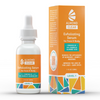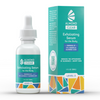How Long Does it Take Mandelic Acid to Work?
We know, we know-- when you start a new skincare routine, you want it to start working immediately! The number one question that we get in our Instagram DMs is “how long will it take to start seeing results?!” We get it, it’s exciting to start a new routine, and the chance that you can see rapid improvements keeps you checking your skin multiple times a day. But like all new skincare routines, results from mandelic acid application will generally occur over a period of time. Some skin concerns are quicker to start improving than others, so we wrote this guide to let you know when you can expect results for the following skin concerns: 1) acne, 2) folliculitis, 3) ingrown hairs, 4) hyperpigmentation, and 5) aging skin.
Before we jump into it, we’ll give you a super quick recap on Mandelic acid (MA). MA is an alpha hydroxy acid that’s derived from bitter almonds. It is a chemical exfoliant, meaning it removes layers of debris through a reaction with the skin, and it’s also strongly antimicrobial and anti-inflammatory. A wide variety of skin concerns can be improved with regular application of MA.
Let’s see how each skin concerns reacts to mandelic acid and how long it generally takes to see results:
Mandelic acid and acne

Mandelic acid is super effective at banishing face and body acne! MA clears stubborn clogged pores by exfoliating congested material like dead skin cells and oil from the surface of the skin. The acid dissolves the congested material responsible for plugging the pore so that it can wiggle itself free and exit the pore. Using mandelic acid can also help to regulate sebum production (skin’s natural oil) and can reduce inflammation that’s responsible for making the blemish appear red and swollen.
How long does it take to see results?
Some people see results from using mandelic acid for acne in the first two weeks, but for most people it will take about a month to start seeing noticeable improvements. This is because acne treatments need time to clear out all of the congested material inside your pores and prevent new clogs from forming.
When you first start a new acne product, plugs that were already forming under the surface of the skin (called “microcomedones”) will continue to come to a head as whiteheads or cysts until the acne treatment has time to stop new plugs from forming. It takes about three to four weeks for a clogged pore to build from a microcomedone into a larger, visible pimple. Once the old microcomedones are gone and new ones have been prevented from forming, your skin gets clear. That’s why it generally takes about 28 days to fully clear your skin with a skincare treatment like mandelic acid.
You can help your chances for seeing quick improvement by being very consistent with your skincare routine.
Mandelic acid for folliculitis

If you don’t know what folliculitis is, you’re not alone! Essentially, folliculitis is a fungal or bacterial infection of the hair follicles. It looks a heck of a lot like regular bacterial acne, yet it’s caused by different factors and has some special skincare requirements.
Because mandelic acid is strongly antibacterial AND antifungal, it clears up the microbes that are responsible for causing folliculitis. No one other AHA seems to have such strong antifungal properties, which makes MA the best skincare acid for folliculitis. Additionally, because mandelic acid is highly exfoliating, it sloughs off dead skin cells and oil to unclog blocked hair follicles. MA also reduces redness and inflammation because of its anti-inflammatory properties.
How long does it take to see results?
Fortunately for folliculitis sufferers, people typically start to see results a little faster than with regular acne because mandelic acid is strongly antimicrobial, and microbes (bacteria + fungus) are the main drivers of folliculitis.
Most people will start to see a visible improvement within two to three weeks of consistent mandelic acid application. You can help expedite the process of clearing folliculitis by not picking or scratching the bumps. When you do this, the infection spreads around causing more folliculitis to sprout up.
Mandelic acid for Ingrowns

An ingrown hair occurs when the tip of the hair curls back or grows sideways into the skin of the hair follicle and gets trapped there. From there, ingrown hairs can become super inflamed and are very prone to bacterial infection. The most common cause of ingrown hairs is from shaving or waxing, typically in the beard area, bikini area, legs, and armpits. Ingrowns are more likely to occur this way because shaving and waxing creates thin hairs with sharp edges that are more likely to grow sideways or poke back under the skin and get trapped. Other times, the culprit is dead skin cells that can clog a hair follicle and force it to grow sideways under the skin, rather than up and out.
The good news is that mandelic acid works wonders for ingrown hairs! This can mostly be attributed to mandelic acid’s effective exfoliating properties. MA gently exfoliates the top of the skin to remove dead skin cells, oil and other clogged material from the hair follicle. By doing this, MA clears the way for the hair follicle to come to the surface of the skin where it can be removed with sterilized tweezers.
Another great benefit of using Mandelic acid on ingrowns is that it reduces swelling and redness of razor bumps and angry-looking boils, due to its antibacterial and anti-inflammatory properties.
How long does it take to see results?
Mandelic acid can help reduce the swelling of red, inflamed ingrowns within a day or two, and if applied consistently, many ingrown hairs are brought to the surface within a week to ten days. Severe, long-term ingrowns may require additional treatment from an esthetician or medical spa.
When MA is applied regularly over time, it can prevent new ingrowns from forming. If you consistently apply mandelic acid to your ingrown-prone area, that layer of dead skin cells will get sloughed off and ingrown hairs will be less likely to get trapped under the skin.
Mandelic acid for hyperpigmentation

Hyperpigmentation generally looks like uneven patches of skin, such as dark marks from acne scars and sun damage. The best way to fade hyperpigmentation is to exfoliate the top layer of dead skin cells so that new, fresh, bright skin cells can come through, replacing the discolored layers. Mandelic acid does just this, all while inhibiting the production of melanocytes (melanin-forming cells) so the hyperpigmentation process is interrupted. It also improves the tone and texture of the skin, making the skin appear brighter, smoother and more glowy.
How long does it take to see results?
The frustrating thing about hyperpigmentation is that it fades gradually over time. Although mandelic acid is excellent at fading hyperpigmentation, it can still take anywhere from two to four months to see dramatic improvements. This is because fading hyperpigmentation requires exfoliating many layers of discolored skin, and this has to happen slowly, layer-by-layer. The key is consistency, so don’t skip your daily skincare routine!
If you’re really wanting to speed up the fading process, getting a professional chemical peel can expedite it by removing multiple layers of skin at once.
Mandelic acid for fine lines and wrinkles

Mandelic acid can decrease the appearance of fine lines and wrinkles because it stimulates the skin to produce collagen and elastin; two naturally occurring proteins found in the skin that are responsible for keeping it taught and plump. With the increased collagen and elastin levels that MA stimulates, the skin appears smoother and fine lines are less obvious.
MA also creates a more youthful glow by creating turnover in dead skin cells. Mandelic acid exfoliates the skin, getting rid of those old, dead skin cells that can appear dull and heavy on the surface of the skin, and generates new, healthy, plump skin cells. These fresh skin cells are fully hydrated and reflect the light more than the older, dull, dry cells, so your skin takes on a vibrant, healthy glow.
How long does it take to see results?
Typically, people will notice smoother, more glowing skin within just a week of consistent MA application. This is because mandelic acid exfoliates that top layer of skin, and once that’s gone, you’re left with new, bright, fresh skin cells. Firmer, more plump skin will be achieved over the course of several months as the production of collagen and elastin are stimulated.
Final thoughts
Although we want our skin concerns to vanish overnight, the reality is that new skincare routines take time to bear fruit. The key to great results is to be patient and consistent over the long-haul. Applying an AHA powerhouse like mandelic can speed up the clearing process and help you to get the awesome results that you’re looking for.
Like what you read? Want to chat about skincare with people who have the same skin concerns as you? Join our Facebook Group- Almond Clear Skincare Support.








